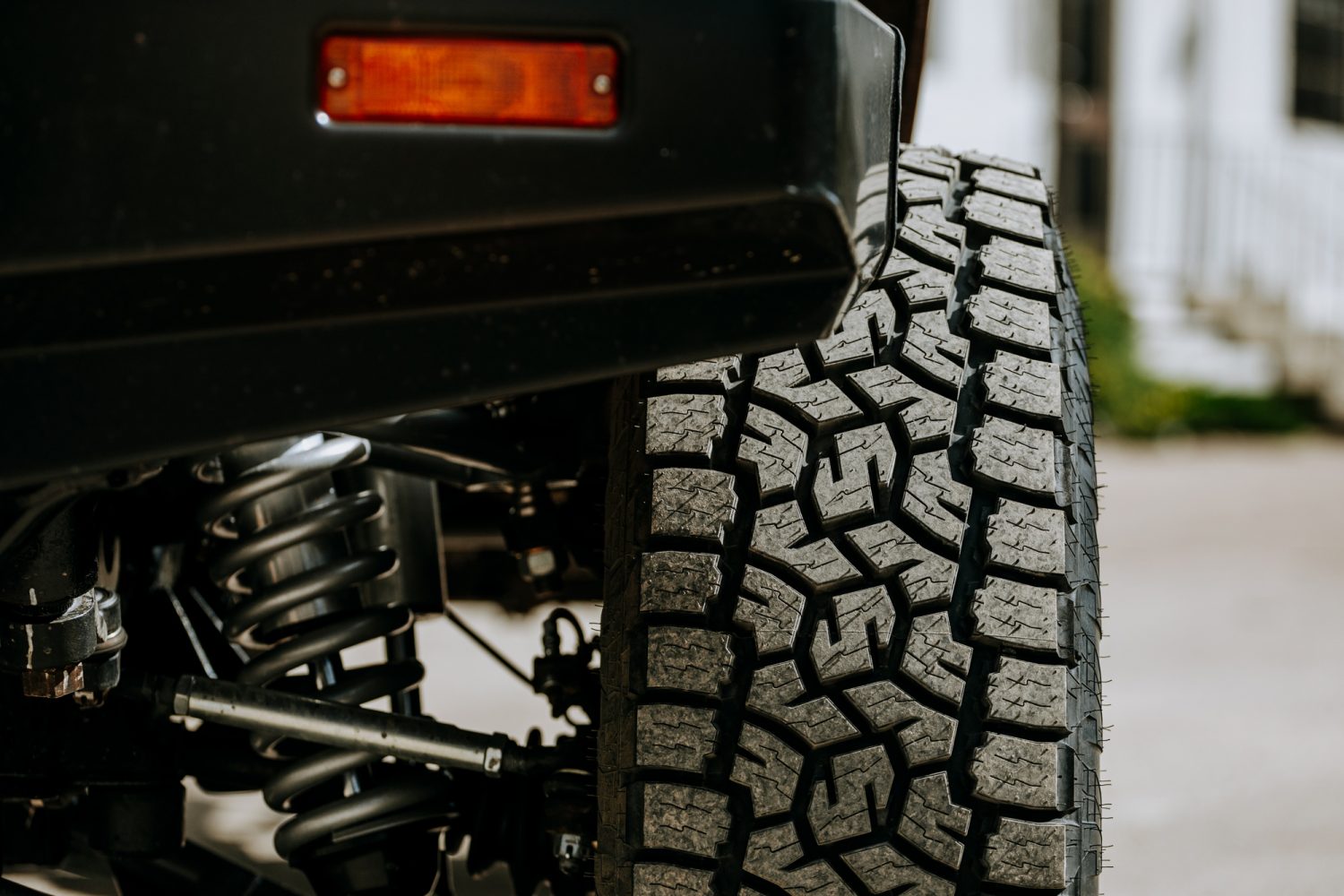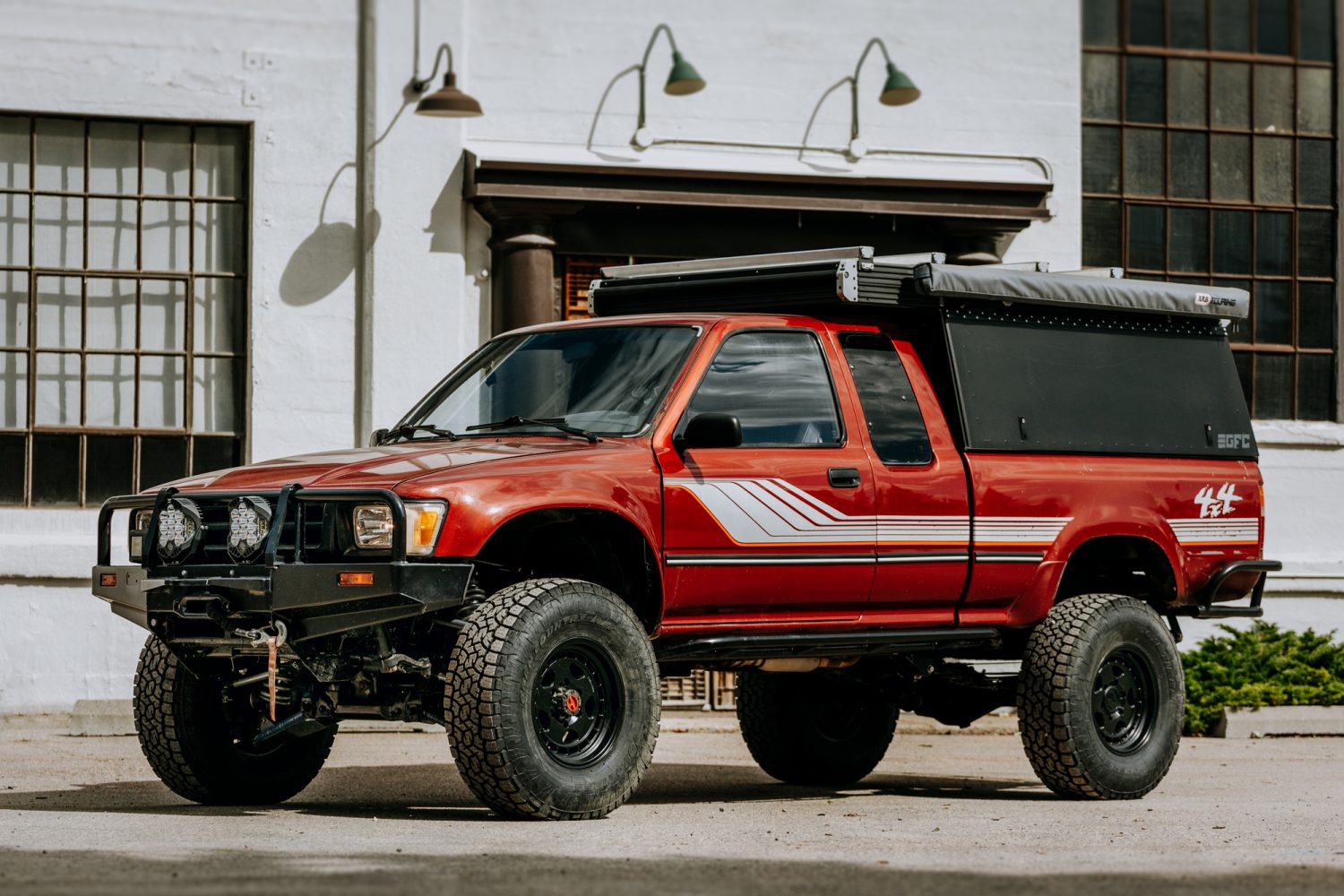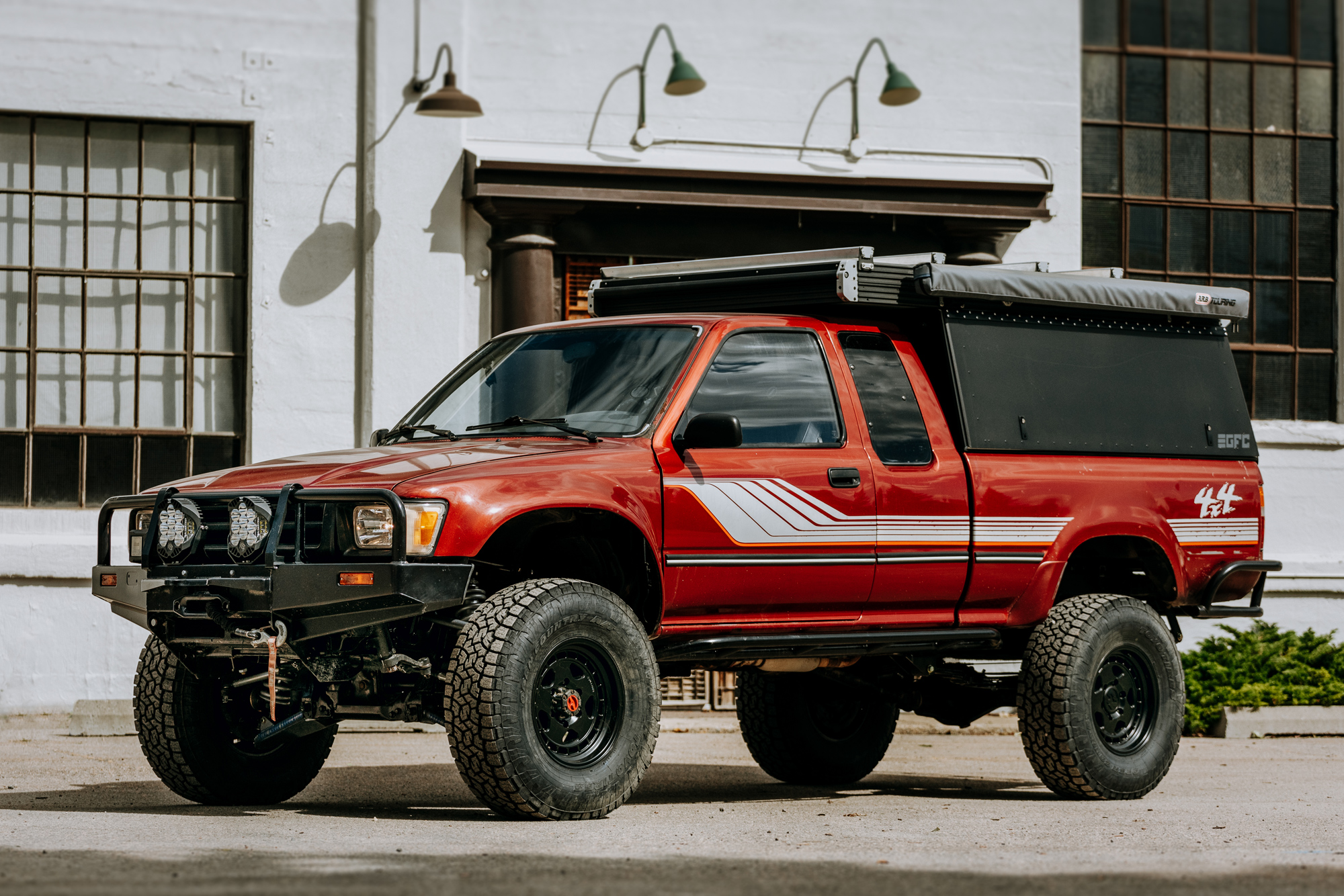Suspension is one of the most important components of any overland vehicle build. The time, effort, and dollars spent on shocks and springs are realized each and every time you drive. You’ll be reminded of your good (or bad) suspension design on every corner, pothole, washboard road, or Mexican tope.
We chose the tried-and-true Old Man Emu (OME) suspension system for the first build version of our 1990 Toyota Pickup. The OME kit is a great value, completely bolt-on, and able to support a fully loaded payload without complaint. After 70,000 kilometres of overland travel from Canada to Argentina and back along with another 30,000 kilometres at home, we had zero suspension issues and spent absolutely no time on maintenance.


Despite this reliability, 30+-year-old suspension technology had left us (and our spinal columns) wanting more. We could have simply replaced the worn-out OME Nitrocharger shocks, but additional comfort and performance were in order. This time around, we were willing to spend some money, as well as time on maintenance, to get there.
A great middle-of-the-road suspension option would have been replacing the factory upper control arm with an aftermarket option, allowing for more articulation and the ability to accept longer high-performance shocks, all while maintaining factory alignment specs. This combination works so well because it’s super simple and produces huge benefits in terms of suspension function and passenger comfort. Unlike the plethora of upper control arm options for modern trucks, we didn’t have that luxury with our 30-year-old Pickup. Instead, we went from 0 to 60 really quickly and ordered a Total Chaos +3.25-inch Long Travel Caddy Kit.
We’ve been very happy with the Total Chaos upper control arms and Fox 2.5 shocks on our Tundra, so utilizing similar components on our 1990 Toyota Pickup made perfect sense. The 4130 chromoly tubular upper and lower control arms bolt to factory mounting locations and use uni-balls in the upper control arms to provide 12 inches of front wheel travel. Yep, that’s about 60 percent more wheel travel than the factory setup. The current version of the Total Chaos kit uses a weld-on shock hoop kit that allows us to remove the factory torsion bars and install an 8-inch travel 2.5 coilover. Modern suspension performance, here we come!


Let’s be honest. Performance on pavement is arguably more important than off-road performance. As overlanders, we likely spend just as much time on the road than off. Sure, we love the idea of driving down the Baja Peninsula, following part of the legendary Baja 1000 race route, but to do so usually requires driving hundreds of miles of highway before we even cross the beloved Tijuana border. Want to continue farther south? Well, many of those roads are paved. For example, most of the off-road driving during a Pan-American trip is elective and not required to reach the bottom of Argentina.
Optimizing on-road performance is one of the many reasons why we’ve decided to keep the truck’s independent front suspension instead of swapping in a solid axle. The Total Chaos long-travel kit allows the truck to stay nice and low, for a lower center of gravity, compared with a solid axle-swapped Toyota. The unsprung weight also remains relatively low, and therefore easier for the shocks to control.
Overall strength may not be required, but the long-term durability of a suspension system is paramount. Have you heard of the Dakar Rally? Yeah, this Total Chaos system is Dakar-proven, so it should be able to handle our long jaunts down dirt roads just fine. The Total Chaos idler arm is definitely something we should have installed years ago, you know, before we replaced the factory unit three times over three years. The rebuildable idler arm bolts in to the factory location and is designed to handle the abuse of larger tires and brutal roads. We’ll store both an idler arm rebuild kit and a pair of spare upper uni-balls in the truck. Based on a 50,000-kilometer trip, and a conversation with Total Chaos, we likely won’t need to replace them while on the road, but since these are some of the only non-factory wear parts, it makes sense to have a couple on hand.

One downside of increased suspension travel is the potential for more wear on the CV axles. Additional vertical movement in the axles means that you could potentially see a premature failure of both the axle and the boot. Unfortunately, Genuine OEM Toyota axles were out of stock, so we chose an aftermarket replacement. We did, however, install Toyota CV boots as their quality is substantially higher than those found on most aftermarket replacements. We’ll set the ride height as low as possible in order to keep the CV angles as close to stock as we can, therefore reducing wear during normal driving scenarios.

Predictable and safe handling begins with a solid foundation of a properly designed suspension system. By utilizing factory mounting points and engineered components from Total Chaos, we know that the geometry is correct. The next step was to use springs that support the weight of the vehicle and shocks that are designed to control the suspension movement both off road and on highway.
Our truck is fairly light in the front (even with the ARB front bumper and M8000-S Warn winch) because of the itty bitty 2.4L four-cylinder engine. Also, we don’t plan on jumping this little overland truck, so 18-inch long 500-pound/inch Eibach springs up front, and a pair of custom 63-inch long leaf springs will do a fine job of handling the payload. For those dynamic times when the springs and shocks can’t handle the load, the Timbren front bump stops will reduce the kinetic energy in a controlled way.

We went back to an old-school trick for the rear suspension. Toyota enthusiasts have used 63-inch Chevy springs for years as a way to gain more travel from a mini truck’s rear suspension. The long flat springs allow for a ride that is softer but that can still provide the payload capacity necessary for an overland build. We purchased Sky’s Off-road Design Kit, which included all of the parts necessary to install the springs. In the past, I have fabricated my own components for similar swaps, but after adding up the cost of materials, it made sense to spend the $230 on this kit and save the time.


Instead of picking up a set of junkyard leaf springs, we had Calgary Spring in Alberta build a custom pack for us. An important thing to note with these springs is that they’re so flat to begin with, it’s easy to invert them and permanently bend them. To prevent this, we installed extended-length Timbren rear bumpstops out back.

For this build, we installed front and rear shocks from Icon Vehicle Dynamics. Longer travel and better control, due to increased piston area (because of the larger diameter) over stock components, means that the Icon shocks will help the truck handle technical obstacles and high-speed dynamic inputs much better than the stock Toyota or Old Man Emu units. The additional fluid volume provided by the remote reservoirs helps the shocks remain cool and resist fading over long drives on rough roads.
You can’t always have your cake and eat it too. The biggest problem with race car parts is that they come with race car problems. Rebuilds and replacements are expected at more frequent intervals than factory components, but again, we’re not running the Score Baja 1000. We anticipate driving on paved roads, lots of gravel, and plenty of rough roads. Short-term, high-impact use (such as a race event) increases rebuild intervals, whereas time spent on paved and gravel roads extends that interval significantly. We’ve never owned Icon shocks, so we thought it prudent to talk to those who have real-world experience. After a few conversations with other long-term overlanders, a local off-road shop, our own experience on Icon-equipped Expedition Overland trucks, and conversations with Icon, we have a good idea of how long we’ll be able to travel between shock rebuilds and can plan around it. A range of 60,000 to 80,000 kilometers is common for use cases similar to ours, which will be long enough for the extended trip we have in mind.


Since Icon doesn’t have a specific shock for our long-travel 30-year-old Pickup (go figure), we had a conversation with Adrian Aldama at the company to discuss our wants and needs. We provided him with the details on the weight of the truck, max/min shock lengths, and intended use. He then designed a custom set of shocks for our truck. These are valved according to the details above, but since payload can change and road conditions always change, the shocks come with adjustable Compression Damping Control (CDC) valves. The CDC valve is an externally adjustable valve that restricts oil flow into the reservoir, creating 10 levels of compression damping force ranges. Controlling the amount of oil flow externally allows for optimal adjustment damping for varying terrain.

To limit the amount of overall maintenance required, we made sure to replace all of the steering components and lower ball joints with Toyota genuine OEM parts. Most of these factory components are sealed and won’t require maintenance. We had good luck sourcing these components throughout the Americas and expect they can be found elsewhere around the world without issue.


WHEELS AND TIRES
The Total Chaos long-travel kit increases track width by 6.5 inches overall. We tucked the tires in a couple of inches overall by changing wheels to Fifteen52 TurboMac HD Classics 16×8 with zero offset.


The Toyota fiberglass high-clearance fenders help to keep a bit more of the tire tread in the wheel well and dirt under the truck instead of covering the side of it.

Speaking of tread, this is the first time we’re planning a long-term trip on all terrains. In the past, we were of the mindset that the additional strength of a mud terrain was worth the compromise in road noise and weight. This time, we decided to save several pounds per corner and increase wet weather and winter performance. Our time spent living amongst the Rocky Mountains has taught us that a good all terrain is the choice if flurries are in the forecast. We wrapped the Fifteen52s in Toyo Tires’ new three-peak mountain snowflake rated ATIII tires. The 285/75R16s have already been proven to work well with the previously installed 4.88 gears; they can be found worldwide and fit perfectly in the original spare tire location under the truck.

DRIVING IMPRESSIONS
After all that work, how did it perform?
Our biggest concern about on-road performance was that we would make our 1990 Toyota Pickup worse. The truck drove surprisingly well for something that was 30 years old. We assumed there was nowhere to go but down. Thankfully, this truck drives much better on pavement than it used to. There’s a little more body roll through corners (sans sway bar), but it feels planted. This body roll is easily tuned out with a few clicks on the compression damping adjusters. The little undulations in the road, unexpected potholes, and railroad tracks are soaked up without issue. You know those moments when you see a pothole or dip too late and your body tenses, waiting for the impending jolt? That still happens, but instead of bottoming out, the suspension soaks it up and continues on without complaint. I’m thoroughly disappointed that we didn’t have this setup for the countless surprise topes in Mexico.
The slow-speed off-road capability was something I wasn’t too concerned about improving, but the flexible rear springs and long-travel front allow the suspension to articulate significantly more than it has in the past. Keeping the tires on the ground meant that the torsion-style limited slip in the rear differential does its job to keep the truck moving forward.
Driving quickly off road is where this suspension really shines. The bigger the potholes, whoops, or g-outs, the better (to a point, this is still a lightly modified mini truck after all). The faster we went, the bigger our smiles were. We’re suckers for mechanical empathy, especially on long trips, so we don’t plan on being too hard on this little truck, but it’s nice to know it works well when we want it to.
Granted, this evaluation was only over several camping trips, so there can only be so much experiential feedback at this point. You’ll have to be patient for our long-term thoughts as we get more time behind the wheel and on the dirt.

COST VS. PERFORMANCE
Was it worth it?
Cost is the biggest downside to this suspension system. Without including labour or the replacement factory parts, a similar suspension system costs about $5,000 more than the Old Man Emu system.
We installed an Old Man Emu suspension on the first version of this build because it was BY FAR the best value for us. Since then, we’ve been exposed to different options. We’ve spent weeks in Harry Wagner’s ADS/Deaver equipped first-gen Tundra, months in Expedition Overland’s fleet of Icon-equipped trucks, and a couple of years of daily driving our Tundra on Fox 2.5s. We’ve also been in two Total Chaos shop trucks and a Trophy Truck in the last couple of years. We have become too aware of the performance increase that’s possible with the right parts.
It’s hard to say whether it’s “worth it” for us and impossible to say if it’s worth it for somebody else. The extra $5,000 spent on this can go a long way to pay for a long-term overland trip. If that amount of money will prohibit or delay a trip, then it’s probably not worth it for you. You’ll have to weigh the pros and cons to see if a setup like this is what you want or what you need.
Did we need this? No.
Did we want this? Absolutely.
PARTS LIST
#95200 Total Chaos urethane pivot control arms
#95130 Total Chaos idler arm
#95602 Total Chaos weld-on shock hoop
#95289 Total Chaos weld-on truss
CB1679 ICON Vehicle Dynamics 2.5 emulsion front coilovers
CB1680 ICON Vehicle Dynamics 2.5 front shocks with piggyback CDCV reservoir
CB 1681 ICON Vehicle Dynamics 2.5 rear shocks with CDCV remote reservoir
1800.300.0500S Eibach 500-pound, 18-inch long front coil springs
63-inch Chevy rear springs, locally sourced at Calgary Spring
TOY-CSPM-001 Sky’s off-road design, Stage 2, 63-inch Chevy spring hanger kit
Timbren extended-length rear bump stops
Aftermarket replacement T100 axles
7210 Procomp braided steel extended brake lines
93-83-150T G2 axle 1.5-inch forged rear wheel spacers
PN 4333039265 Toyota genuine lower ball joints
PN 4504639385 Toyota genuine steering tie-rod ends
PN 45406391852 Toyota genuine steering tie-rod ends
PN 4545139145 Toyota genuine steering center link
PN 4540135220 Toyota genuine steering Pitman arm
Follow along with Richard and Ashley’s adventures at www.desktoglory.com and on Instagram at @desktoglory.


